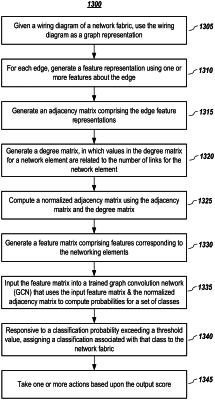| CPC G06N 3/08 (2013.01) [G06F 30/18 (2020.01); G06N 3/04 (2013.01)] | 20 Claims |

|
1. A computer-implemented method for predicting a classification of a network fabric design, the method comprising:
given a feature matrix and a corresponding adjacency matrix obtained from a graph representation of a wiring diagram of the network fabric design, which comprises a plurality of networking elements and network-related connections between two or more networking elements, inputting the feature matrix and the corresponding adjacency matrix of the network fabric design into a trained graph convolution network (GCN) model, which was trained by performing steps comprising:
obtaining a set of feature matrices and a set of adjacency matrices corresponding to a set of training wiring diagrams, in which, for each training wiring diagram of a set of training wiring diagrams, its feature matrix and its adjacency matrix were obtained by performing steps comprising:
given the training wiring diagram of a network fabric design comprising a plurality of networking elements, which are functional systems or devices, and network-related connections between networking elements, using the training wiring diagram as a graph representation, in which a networking element is a node and a connection between networking elements is an edge;
for each edge, generating an edge feature representation using one or more features about the edge;
generating an adjacency matrix using the edge feature representations;
generating a degree matrix, which represents, for a networking element, its number of connections;
computing a normalized adjacency matrix using the adjacency matrix and the degree matrix;
for each networking element, generating a feature representation using one or more features about the networking element; and
using the feature representations of the networking elements to form a feature matrix;
iterating until a stop condition is reached steps comprising:
inputting at least some of the set of feature matrices and at least some of the set of corresponding adjacency matrices into a graph convolution network (GCN) model that uses a feature matrix and a corresponding normalized adjacency matrix to determine a predicted classification of a set of classes regarding the network fabric design corresponding to the feature matrix and the corresponding normalized adjacency matrix;
computing a loss using a ground truth classification for the network fabric design and the predicted classification for the network fabric design; and
updating one or more parameters of the GCN model using the loss; and
responsive to a stop condition being reached, outputting the trained GCN model for classifying a network fabric design; and
outputting a classification of the network fabric design based upon a prediction of the trained GCN model.
|